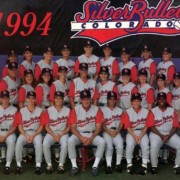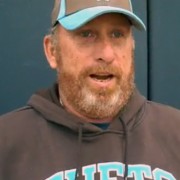Boston Goes Bush League; City’s Fields Suffering From Neglect And Overuse
The baseball skips off the dusty, uneven infield and nearly decapitates the shortstop. It takes another crazy hop in the outfield, forcing the left fielder to perform acrobatics in order to hold the runner to a single.
Such is life on this early June night at Fallon Field in Roslindale, home field of the Triple D’s club in the Senior Boston Park League.
“If anyone wonders why we’re losing ballplayers to the Inter-City League or the South Shore League, all they have to do is look at the shape of our fields in Boston,” says Walt Mortimer, former Park League star and now an umpire and league secretary.
Losing players may be one thing, but losing teeth is another: Two years ago, Triple D’s third baseman Brian O’Leary took a bad hop grounder in the face at Fallon, knocking out two teeth. Three years ago, Jim Gill of the Towne Club was hit by a line drive in the throat at the same park as he sat on his unprotected team bench.
“I’ve been playing in the league for eight years,” says Triple D’s second baseman and pitcher Billy O’Leary (Brian’s brother) and I just haven’t seen much care given to the fields we play on. I agree with Walt. We’re losing good players to other leagues.”
But Mortimer, who had to personally bring a lawn mower to Fallon last year prior to the Park League playoff finals, along with Towne Club manager Skip Landry, say the city is slowly putting a new face on some of the fields this year, particularly Billings Field in West Roxbury.
“But it’s not like the ’50s, ’60s and into the ’70s when each field had its own clubhouse that players could change in and a field attendant who was responsible for one park,” says Mortimer. “And you can’t correct 10 years of neglect in one season,” adds Landry.
Boston’s new park commissioner, William Coughlin, says that in the 1950s, there were more than 400 individuals maintaining Boston’s fields. That number decreased in the 1960s to 363, but jumped in the early ’70s to 383. But by 1985 and through the present, the number had fallen to 155 persons.
The current work force includes just one infield crew to do all the fields in the city and several crews that line and cut grass in various neighborhoods. Some of those crews are at one-fourth the strength of 10 to 15 years ago. A proposal by Mayor Flynn to increase the Parks budget for fiscal 1988 would provide for another 40 to 50 maintenance positions.
“The clubhouses at various fields that were in good shape and used in the ’50s, ’60s and ’70s were abandoned after Prop. 2 1/2 and many have just crumbled,” Coughlin said. “In looking at rehabbing these field houses, estimates are coming in for some as high as $1 million because of structural damage.
“It is my hope to put in at many parks a smaller scale clubhouse that could be used to store equipment and provide bathroom facilities.”
But providing showers and dressing areas, Coughlin says, would take away most of the money available to fix fields, fences and backstops.
An unannounced visit last week to each of the five fields used by the Senior Park League revealed the following:
– Fallon — Team bench on third-base side broken . . . mound of dirt and crater to right of backstop that makes chasing a foul ball dangerous . . . uneven infield and outfield . . . 25 of 167 light bulbs not working . . . missing section of fence in right field . . . best dimensions of all the league parks . . . clubhouse has burned to the ground.
– Casey (formerly Town) Field, Dorchester — Hard as a rock skin infield. . . field is nicknamed the “dust bowl” by players . . . benches, unlike Fallon, are at least protected . . . 30 yards of crabgrass from first base into right field . . . bare spots in outfield . . . graffiti on light poles that would boggle even the late Andy Warhol.
– Kelley Field (MDC), Hyde Park — Bare spots and crabgrass in outfield . . . only 8 of 98 lights out, but lights are burning at 11 o’clock on a weekday morning because of computer problems . . . gently sloping ridge in right field and right-center field formed by football field sideline . . . protected benches, but infield in need of resodding . . . the most used of the MDC’s fields in Boston . . . beautiful night time view of the Blue Hills in Milton over left-center field.
– Billings Field, West Roxbury — New backstop and fences at bench areas . . . crabgrass galore in uncut infield . . . unfilled hole in front of pitcher’s mound . . . front of mound and home plate do not line up . . . pitching rubber out of shape, looks like a boomerang . . . infield “skin” in very good shape, looks recently rolled . . . outfield needs weeding and foul poles . . . clubhouse and rest rooms that will open soon set it apart from the other three city of Boston fields.
– Cleveland Circle, (Cassidy) Brighton — Nicest infield overall of all the parks . . . scrub growth along first-base line . . . shadow over home plate when lights are on because of uncut trees that block the lighting . . . dimensions uneven because of short right field, but players say it’s their favorite field.
“If you were to rate Fenway Park a 10, then you’d have to rate the Park League fields about a 4,” says Terence O’Malley, manager of the Hyde Park Sports club, the defending league champ. “I had a player the other day, a good player, who left the team because of his fear of injury. Players regularly get cuts on their legs just sliding into bases because of the rocky infields.”
The Parks and Recreation Department’s $9.3 million budget has been documented as the least amount per capita of any city in the country — but the funding level is just part of the problem.
Another is that Boston’s 55 parks — that include 33 baseball fields, 41 Little League fields and 50 softball fields that require permits — get a lot of use: There are 10 teams in the senior Park League, 20 teams in the junior Park League, 20 Little Leagues, 10 Babe Ruth Leagues and 20 Catholic Youth teams that receive baseball permits from the Boston Parks and Recreation office.
“And not only are there absolutely not enough fields to meet the demand,” says Coughlin. “they’re heavily overused. Since Proposition 2 1/2 and the lack of manpower to take care of them it’s been impossible to face the hard question of how much usage vs. how much down time to assure careful maintenance. As we begin to turn the corner this year of again becoming a better staffed department, that issue still has to be faced.”
The Park Department issues softball permits to 24 community leagues, 24 leagues sponsored by the Park Department, 20 neighborhood and business leagues and scores of “one-shot” permits for softball outings or practices. Another 46 fields are used by groups that do not seek permits — some because of the condition of the fields.
“Altogether, I’ve issued about 800 permits to teams and leagues this spring and summer for baseball, softball, rugby, cricket, soccer, ultimate Frisbee, bocce ball in the North End and a Tug of War in South Boston,” says the department’s permit cordinator Juan Flores.
“Our fields are often played on for 8 to 12 hours a day, seven days a week,” added Coughlin. “So what we’re facing is the possibility of turning leagues and teams away in order to find time to bring these fields back. You need a couple of days a week for the fields to respond to care.”
Bill Hart, the MDC’s executive assistant director of recreation, agrees: “Our fields also get heavy usage and there’s only so much time, given the manpower to work on them.”
Hart said the commission issues about 200 permits for 10 softball, seven Little League and four baseball fields within the City of Boston. All the fields are maintained by a single traveling crew of eight workers that is beefed up in the summer. “There used to be more staff for maintenance, but the funding for those positions has not been constant,” said Hart, who estimated the MDC recreation department’s budget for personnel and maintenance of its fields in Boston at about $1.5 million.
Josh Powell, director of the 23-team All Dorchester Sports League, says he has no problem with access to Park Department fields for girls softball and boys baseball at Garvey Field, Ronan Park, Casey Field and Clifford, Wainwright and McConnell Parks.
“But all the fields we play on really need major work, particularly their drainage systems and their playing surfaces. We couldn’t use Roberts Field (behind Dorchester High) this year because of its condition — but it’s scheduled to be worked on next month,” said Powell.
“Prior to the Flynn administration, the fields really weren’t in good shape — in fact they were deplorable. We were embarrassed to invite teams outside Boston to play us. But I’ve been to several meetings with the city and I feel there’s a commitment to improve the fields.
“McConnell Park and Casey Field have been better maintained this year — you can see people out there working. I think, in the long run it makes more sense to reconstruct each field systematically, rather than do Band-Aid repairs to all fields in the city,” added Powell.
Coughlin said that digging up fields and replacing them with Fenway Park- type sod is unfeasible because of their heavy usage.
“In my first four months here, I’ve directed that we launch a major long- term turf maintenance program that does not show the quick-hit impact of fancy new sod, but that in two to four years will show systematic improvements in our fields,” he said.
“My preference is toward seeded grass which may not look as pretty but will last a lot longer.”
Coughlin said the city has surveyed 170 ballfields and that as a result five fields that will have been resodded by the end of the summer — Carter Playground in the South End, Lee/M St. in South Boston, Hemenway in Dorchester, Ross Field in Hyde Park and East Boston Stadium — will receive “an aggressive” turf maintenance program this fall.
Coughlin said the survey also indicated it would cost approximately $4 million for an annual turf maintenance program in which crews would systematically aerate fields four to six times a year; slice-seed portions of fields annually and “intensively” water every field throughout the nonsummer months.
“The shame of it is that it’s going to cost a lot more to fix the fields than it would have been to maintain them over the years,” says Hyde Park Sports’ O’Malley.
Added Coughlin: “We’re turning the corner, but we’ve got a long way to go.”
Copyright © 1987 Boston Globe, all rights reserved. Written by Marvin Pave.





Leave a Reply
Want to join the discussion?Feel free to contribute!